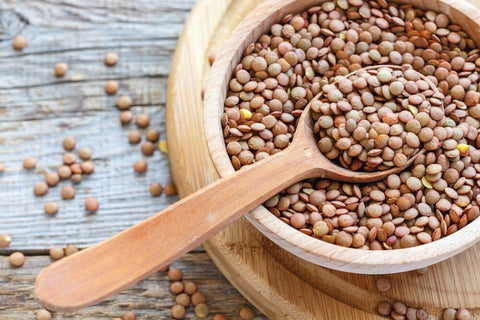Lentils stand out for their high energy value and at the same time are a food rich in protein. They are also a source of carbohydrates while the fat content is almost non-existent, making them an ideal food for those who perform a high level of exercise. physical activity, such as athletes.
Among the varieties of these small round seeds, the most notable are the green, brown, red and blue, among others. In addition, these are the only legumes that do not need to be soaked in water to be hydrated. But beyond the preparation of stews, lentils are also an ideal ingredient for making salads.
Properties
Lentils, like other legumes, provide a good amount of protein and fibre, as well as a wide variety of minerals, some in much higher quantities than other foods. This nutritional composition makes lentils a food with numerous health properties and a low calorie content, making them lighter than is often thought.
PROTEINS IN QUANTITY
Lentils contain 23.5% protein, more than beans or chickpeas, and also more than meat, fish and other animal products, although these are not dehydrated and are eaten in larger portions.
Lentil proteins have the advantage over those of animal origin in that they are not accompanied by cholesterol or saturated fats, are easy to digest and are surrounded by other interesting nutrients.
This significant protein contribution makes lentils a basic food in any diet, with a very advantageous economic and ecological cost compared to meat.
CARBOHYDRATES
One of the properties of lentils is that they provide a great source of energy for both physical activities and for feeding the brain for concentration and studying.
They are also complex carbohydrates that are absorbed slowly, so the glucose passes into the blood gradually without causing spikes in blood sugar.
This is particularly beneficial for diabetics. Its glycemic index, between 21 and 30 depending on the variety, is well below the average.
DIGESTIVE FIBER
Lentils contain more than a tenth of fiber, both soluble and insoluble, which contributes to the slow absorption of glucose.
Fiber also provides a high satiating power, facilitates intestinal transit, exerts a prebiotic effect on the microbiota and reduces the risk of colon cancer.
It also helps to eliminate bile salts and cholesterol. However, the contribution is lower than that of other legumes, such as beans, which makes them more digestible and less flatulent.

MAIN SOURCE OF MINERALS
Another of its strengths is its richness in minerals. A single serving (80 g raw) covers a high percentage of the daily needs of the most important ones, such as iron, potassium, calcium, magnesium, phosphorus, zinc and selenium.
Iron : One serving provides more than a third of the daily iron requirement. You can improve the absorption of iron from lentils if you eat them with foods rich in vitamin C, such as peppers, tomatoes or vegetables and fruits in general.
Potassium: Found in high concentrations in lentils (810 mg/100 g). It regulates body fluids and prevents hypertension.
Calcium: found in moderate amounts but in balance with phosphorus and magnesium. It regulates the health of the bones and the nervous and muscular systems.
Phosphorus: one serving provides 40% of the recommended daily amount. It is essential for communication between neurons, proper skin pH and the formation of muscle tissue, bones and teeth.
Magnesium: A serving of lentils provides 20% of the daily requirement. It strengthens bone tissue, as well as the neuronal, muscular, cardiovascular and immune systems.
Zinc : one serving covers 17% of daily needs. It is essential for the immune system and facilitates the absorption of vitamin A and the synthesis of proteins such as collagen.
Selenium: It is a great antioxidant, it stimulates immunity and the thyroid gland. One serving provides 13% of the recommended daily amount.

Benefits
The richness of the nutritional composition of lentils makes them great allies of health. These are their benefits:
LOW CALORIES AND VERY NUTRITIOUS
Lentils are almost completely fat-free, so, contrary to popular belief, they are a light food that provides only 250 calories per plate (about 80 grams of dry lentils, the usual serving per person).
This makes them suitable for weight control menus. Cooked simply, such as in vegetable stews or salads, they can be the basis of very nutritious and tasty menus.
PROTECT THE NERVOUS SYSTEM
Lentils have benefits for the nervous system due to their content of B vitamins, especially B1, B2, B5, B6 and folic acid. When cooked, some of their content is lost, but if they are eaten sprouted, it is increased.
ANTI-ANAEMIC
The well-known richness of iron in lentils justifies their recommendation in cases of iron deficiency. To enhance their assimilation, they should be eaten with some food rich in vitamin C, such as a salad with red pepper or an orange for dessert.
CHOLESTEROL UNDER CONTROL
The soluble and insoluble fiber in lentils (10% of their weight) absorbs cholesterol and prevents it from reaching the bloodstream.
In addition, lentils contain phytates and antioxidants with an anti-cholesterolemic effect, improving cellular metabolism and the use of fatty acids as a source of energy for the cell.
NUTRITIONAL VALUE OF LENTILS
In general, lentils provide, per 100 grams:
Protein: 23.8 grams
Fats: 1.8 grams of fat
Carbohydrates: 54 grams
Dietary fiber: 11.7 grams
They also contain vitamin B1 and B2, niacin, vitamin B6, folates, some vitamin C and vitamin A, calcium, iron, magnesium, zinc, potassium, phosphorus, selenium and a little sodium.

Lentil Salad with Radishes and Kale
Ingredients
Dressing:
Extra virgin olive oil
-
Juice of one lemon
3 cloves garlic, grated
1 teaspoon Dijon mustard
1 teaspoon salt
¼ teaspoon ground cumin
Ground black pepper
Salad :
200 grs cooked lentils
3 cucumbers, thinly sliced
100g yellow or red grape tomatoes, cut in half
1 red onion, chopped
4 leaves of Kale, finely chopped
4 red radishes, thinly sliced
200 grs of crumbled feta cheese
-
125 grs of pitted green olives
A bunch of chopped fresh parsley
A bunch of fresh mint leaves
Elaboration
Prepare the Dressing: In a large bowl, mix the olive oil, lemon juice, garlic, mustard, salt, cumin and pepper.
The Salad: Add the lentils, cucumbers, tomatoes, red onion, kale, radishes, feta cheese and olives to the bowl with the dressing and toss to coat. Add the parsley and mint and toss again.






Comments (0)
There are no comments for this article. Be the first one to leave a message!